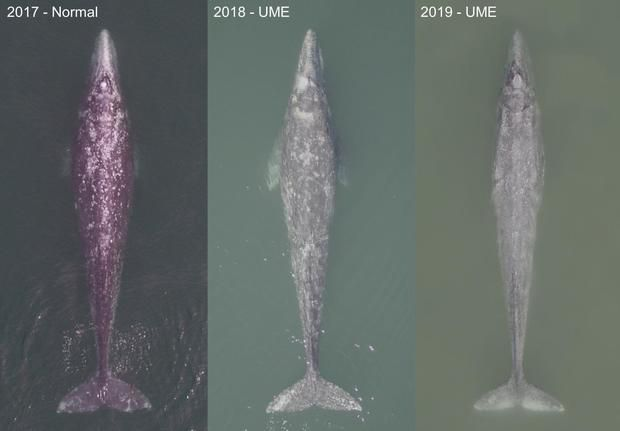Scientists say the die-off, which is entering its third year, is likely due to a scarcity of food in the animals’ cold water feeding grounds

Three adult gray whales photographed via drone in 2017, 2018 and 2019 in Laguna San Ignacio off the coast of Mexico. The three shots show increasingly skinny whales, a bad sign for an animal that needs to make a 10,000-mile return trip to reach its feeding grounds.
Reports of emaciated gray whales have started to come in as the whales arrive at their breeding grounds off of Baja California, Mexico. If the trend continues this will be the third hard year in a row for the North Pacific gray whale population, with hundreds turning up dead in what scientists are calling an unusual mortality event, reports Isaac Schultz for Gizmodo.
According to new research published this week in the journal Marine Ecology Progress Series, the die-off began in January 2019 and as of the paper’s publication, the official death toll stood at 378. The species’ last unusual mortality event occurred around the year 2000 and claimed the lives of some 600 whales, according to Gizmodo.
Every winter the gray whales of the North Pacific head some 10,000 miles south from their cold water feeding grounds in the Bering, Chukchi and Arctic seas to breed off the more hospitable but less bountiful waters off Southern California and Mexico, reports Chrissy Sexton for Earth.com.
To build up the fat reserves the whales need to survive and successfully reproduce during their stay in the balmy southern climes, they have to feed non-stop from May until October. If the whales can’t eat enough to pack on a thick layer of blubber, it can spell doom for the marine mammals, who may die en route to their breeding grounds or lack the energy reserves to make the return trip, according to a statement.
“It appears that a large number of gray whales are leaving their feeding grounds already in a poor nutritional state and by the time they have completed the breeding season in Mexico they have depleted their energy reserves and starve to death,” says Fredrik Christiansen, a whale researcher at Aarhus University and co-author of the research, in the statement.
Researchers aren’t sure exactly what’s causing the current bout of starvation, but the authors of the paper suggest that the simplest explanation may be a scarcity of food in the Bering Sea, per Gizmodo. As for what might be behind a scarcity of food, it’s hard to ignore how climate change has wrenched the whales’ feeding grounds. Both the Bering Sea and the Chukchi Sea have been hit with record low extents of sea ice and record high ocean temperatures in recent years.
To reach their conclusions Christiansen and his co-authors made aerial observations of gray whales using drones beginning in 2017. The researchers made systematic assessments of the whales’ size and fat stores using these photos and found that beginning in 2019 the whales started to slim down.
“What stood out in this case was that we had emaciated juveniles and adults,” Christiansen tells Gizmodo. “That’s not normal.”
In a separate research paper released last week, scientists with the National Oceanic and Atmospheric Administration (NOAA) said that the North Pacific gray whale population as a whole has shrunk by nearly 25 percent since 2016, the Associated Press reports. NOAA researchers counted roughly 6,000 fewer whales last January, for a total of 21,000, compared to 2016 when they saw 27,000.
Though the numbers may sound dire, NOAA tells the AP that this die-off isn’t outside the bounds of normalcy. Instead, it could be a sign that the number of whales simply exceeded what the marine environment could support and doesn’t indicate a long-term threat to the whales’ survival.
https://www.smithsonianmag.com/smart-news/nearly-400-gray-whales-have-died-west-coast-2019-180976847/